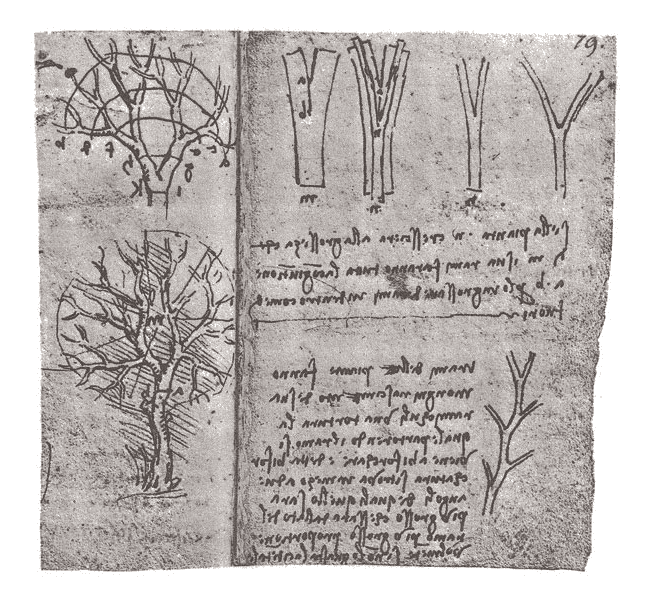
Leonardo da Vinci is a name synonymous with the Renaissance, remarkable for his contributions to art, engineering, and anatomy. But did you know that this prodigious polymath also dipped his toes into the realm of botany?
Among Leonardo’s 13,000 pages of notes and drawings — what we collectively refer to as his “Codex” — lies an observation that’s come to be known as “Leonardo da Vinci’s rule of trees.” Simply put, this rule posits that the total cross-sectional area of a tree’s branches is equal to the cross-sectional area of its trunk.
In even simpler terms: chop a tree down to a stump, and the collective cross-sectional areas of all its branches will equal the cross-sectional area of the trunk itself. It’s believed that this insight helped the brilliant da Vinci to draw realistic landscapes.
Penned more than 500 years ago, the rule of trees was almost immediately adopted by scientists who were seduced by such an elegant observation. To this day, da Vinci’s rule of trees is still taken by many at face value as true. However, a new study has found that, while valid in some respects, the rule of trees isn’t exactly correct when applied to the internal vascular structures of trees.
Why the rule of trees matters

The rule of trees is very important in ecology. Understanding the proportionality between a tree’s trunk and branches is crucial in predicting how forests respond to environmental stress, such as droughts or diseases.
Moreover, the rule has direct applications in forest management. For instance, it allows for better estimation of the biomass in a forest, which is essential for carbon accounting — a critical tool in combating climate change.
Studies conducted in the past few decades have found that da Vinci’s rule holds true for a wide variety of tree species — though many tree species deviate from the rule. Researchers using 3D scanning technology to assess tree architecture found that the total area of branches comes incredibly close to matching the trunk’s area, seemingly validating Leonardo’s centuries-old observation.
But other studies have since shown that da Vinci’s rule for how trees branch is close, but not exactly right in describing the full complexity of branching. In 2022, Russian scientists at the Petersburg Nuclear Physics Institute released a controversial study that claimed it’s the surface area that stays the same as a tree limbs branch into smaller ones, not thickness.
Now, researchers from Bangor University in the U.K. and the Swedish University of Agricultural Sciences (SLU) have also raised an eyebrow at Da Vinci’s rule. They argue that when you dig into the internal structure of trees, this celebrated principle starts to lose ground.
A not-so-universal law after all
Many scientists have adopted da Vinci’s rule of trees as part of the metabolic scaling theory, which explores how an organism’s metabolism, or the rate at which it uses energy, relates to its size. Scientists believed this rule applied not just to the appearance of trees, but also to how water courses through them.
As water and nutrients flow through a tree — from its roots, up the trunk, and out to the tips of its leaves — this movement naturally faces something “hydraulic resistance.”
When researchers Ruben Valbuena and Stuart Sopp crunched the numbers, they came to a startling conclusion: At some point, the uniformity Leonardo da Vinci talked about just doesn’t cut it.
Imagine a city’s plumbing system. If all pipes were the same size, water pressure would be lost at the furthest points. Similarly, trees have to adjust the dimensions of their internal channels to ensure nutrients reach to every leaf. This requires tapering off the volume, leading to a higher concentration of smaller channels at the edges. It’s like a river that becomes narrower and more turbulent as it flows away from its source.
“While Da Vinci’s rule serves as a great ‘tip’ for artists, it doesn’t stand the test when zoomed in at the microscopic level,” said Valbuena.
The team believes this new understanding will refine theories about how plants function. It might also explain why larger trees are more vulnerable to environmental stressors like drought and climate change.
“One of our aims was to produce a ratio which could be used to estimate tree biomass and carbon in forests. This new ratio will assist in calculating global carbon capture by trees.” Sopp added.
The findings appeared in the Proceedings of the National Academy of Sciences.






